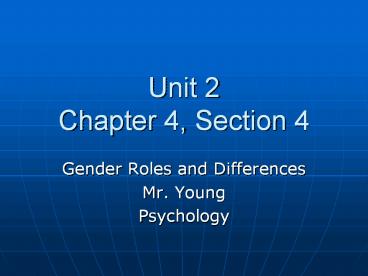Unit 2 Chapter 4, Section 4 - PowerPoint PPT Presentation
1 / 22
Title: Unit 2 Chapter 4, Section 4
1
Unit 2Chapter 4, Section 4
- Gender Roles and Differences
- Mr. Young
- Psychology
2
Gender
- One of the first questions parents ask is, Is
the baby a boy or a girls? - Gender greatly influences how you dress, move,
work, and play
3
Gender Roles
- Gender identity- physical and biological makeup
- Ages 2-3, children label themselves as either
boys or girls - Age 5, most children have learned how to act like
their gender
4
Gender Role Cont
- Gender Role- set of behaviors that society
considers appropriate for each sex - Defined mainly by society and culture
- How each person is suppose to act
- Gender roles can change from society to society
and over time
5
Gender Roles
6
Cont.
- Men viewed as dominant, competitive, and
emotionally reserved
7
Cont
- Women viewed as submissive, cooperative, and
emotionally responsive
8
Cont
- Gender Stereotypes- oversimplified or prejudiced
opinions and attitudes concerning the way men or
women should behave
9
Cont.
- Androgynous- combining or blending traditionally
male and female characteristics - Psychologist Sandra Bem
- Argues that androgyny should be our ideal
characteristic
10
Cont.
- Androgyny is becoming and accepted idea in our
culture - Adolescence have more choices in the way they
define themselves - Young people can now express themselves according
to their talents, temperaments, and values
11
Gender Differences in Personality
- Males more confident than females, especially in
academic areas or in tasks stereotyped as
masculine, such as math and science - Female self-confidence rises when they perform
tasks in which they receive clear and direct
feedback
12
- Males
- Females
13
Male and Female Aggression
- Aggression has the most significant
- Females, more verbal aggressive
- Males, more physical aggressive
- Females feel guilty or have more anxiety about
the dangers involved in aggressive behavior
14
Aggression Cont.
- Males, use mock fighting and rough play
- Females, indirect forms such as talking about,
rejecting, ignoring, or avoiding aggression
15
Male and Female Communication
- Women usually considered more talkative
- Men actually talk more and interrupt women while
talking - Women use hedges (kind of or you know),
disclaimers (I may be wrong or I am not
sure), and tag questions (Okay?)
16
Gender differences in Cognitive Abilities
- No measurable differences in verbal skills exist
between males and females - No significant differences in math
- Men do better on spatial abilities
- Women are better at tracking objects
17
- Male
- Female
18
Biological Theory
- Emphasizes the roles of anatomy, hormones, and
brain organizations - Boys prefer trucks and girls prefer dolls
- Has evolved from the early men and women and how
they acted
19
Psychoanalytical Theory
- Sigmund Freud, children identify with the same
sex parent - Boys identify with fathers, girls with mothers
20
Social Learning Theory
- Children learn their gender roles by observing
and imitating models, such as parents, friends,
peers, teachers - Parents can reward or discourage behavior based
on traditional gender roles
21
Cognitive-Developmental Theory
- Acquire gender roles by interacting with their
environment and thinking about those experiences - Children must first see themselves as that gender
- Form gender scheme- a mental representation of
behavior that helps a child organize and
categorize behaviors
22
Changing Gender Roles
- Most women now have jobs outside the home
- Work provides income and a sense of
accomplishment - Women do not advance as quickly in the workforce,
maybe because of discrimination or because of
childbearing
























![Chapter 18: Cold War Conflicts [1945-1991] PowerPoint PPT Presentation](https://s3.amazonaws.com/images.powershow.com/7237467.th0.jpg?_=20151008125)






